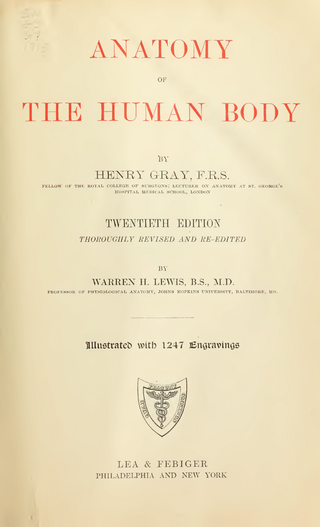
Gray's Anatomy is a reference book of human anatomy written by Henry Gray, illustrated by Henry Vandyke Carter, and first published in London in 1858. It has gone through multiple revised editions and the current edition, the 42nd, remains a standard reference, often considered "the doctors' bible".

Hornbeams are hardwood trees in the flowering plant genus Carpinus in the birch family Betulaceae. The 30–40 species occur across much of the temperate regions of the Northern Hemisphere.
Basic lead acetate, also known as subacetate of lead, is the inorganic compound with the formula Pb3(OH)4(O2CCH3)2. A white solid, it is one of several lead acetates.

Aëtius of Amida was a Byzantine Greek physician and medical writer, particularly distinguished by the extent of his erudition. His birth and death years are not known, but his writings appear to date from the end of the 5th century or the beginning of the 6th.

Robley Dunglison was an English-American physician, medical educator and author who served as the first full-time professor of medicine in the United States at the newly founded University of Virginia from 1824 to 1833. He authored multiple medical textbooks and is considered the "Father of American Physiology" after the publication of his landmark textbook Human Physiology in 1832. He was the personal physician to Thomas Jefferson, James Madison and James Monroe. He consulted in the treatment of Andrew Jackson and was in attendance at Jefferson's death.

Andreas Gerhard Hyperius (1511–1564), real name Andreas Gheeraerdts, was a Protestant theologian and Protestant reformer. He was Flemish, born at Ypres, which is signified by the name 'Hyperius'.
The Archdeacon of Cornwall is a senior cleric in the Church of England Diocese of Truro.
Stedman's Medical Dictionary is a professional medical dictionary developed for medical students, physicians, researchers, and medical language specialists. Entries include medical terms, abbreviations, acronyms, measurements, and more. Pronunciation and word etymology are provided with most definitions. Stedman’s Medical Dictionary and related products are available with a subscription to Stedman's Online.
Selenoplexia, from the Greek words selene, 'the moon', and plexis, 'stroke'), medical category that included apoplectic, a morbid, states or diseased conditions supposed to be caused by the rays of the moon. A Dictionary of Medical Science (1895), in its discussion of the conditions of sunstroke, states that the "morbid phenomena observable after death are generally those of nervous exhaustion, neuroparalysis. Like effects have also been ascribed to the moon, selenoplexia, selenoplege, moonstroke; and to the stars, starstroke."

The Alderman Road Dormitories are one of two main areas of first-year living dormitories at the University of Virginia, the other being the McCormick Road Dormitories. There were originally eleven houses in the residence area located on Alderman Road, which were constructed in the early 1960s to accommodate a large growth in admitted students. In 2006, the University initiated a replacement project after determining that renovating the dormitories would be less cost effective and would not provide more beds for projected enrolment growth. Additionally, the University wants to provide modern amenities for its first year students. The project, which is split into four phases, were finished by 2015.
The Cyclopædia of Practical Medicine was a British monthly medical journal, first published in 1832. It was divided into alphabetical articles, and came to four volumes, part-published and then completed by 1835. The volumes were:
- Abd–Ele (1832);
- Eme–Isc (1833);
- Jau–Sma (1834);
- Sof–Yaw (1835).
The Archdeacon of Croydon is a senior ecclesiastical officer within the Diocese of Southwark. As such the deacon is responsible for the disciplinary supervision of the clergy within its five rural deaneries: Croydon Addington, Croydon Central, Croydon North, Croydon South and Sutton.
The Archdeacon of Loughborough is a senior ecclesiastical officer within the Diocese of Leicester. The archdeaconry was created within the Diocese of Peterborough and from the Archdeaconry of Leicester on 25 February 1921 but became part of the new Diocese of Leicester upon its creation on 12 November 1926.

James Copland (1791–1870) was a Scottish physician and prolific medical writer.

Sane was an ancient Greek city in the Acte headland of Chalcidice, situated upon the low, undulating ground, forming the isthmus which connects the peninsula of Acte with Chalcidice. It was founded by Andrians in the 7th century BCE. The ruins of the ancient city were found in the 21st century. Sane in Acte is mentioned by Herodotus in reference to the march of Xerxes I in Thrace, during the Second Persian invasion of Greece.
The Archdeacon of Sheffield and Rotherham is a senior ecclesiastical officer within the Diocese of Sheffield, responsible for the disciplinary supervision of the clergy within the six area deaneries.

Mazama was a small steamboat driven by twin propellers that operated on upper Klamath Lake starting in 1909. Mazama was, reportedly, the only craft ever to navigate the Wood River, a tributary of upper Klamath Lake. For a few years, until the construction of a rail line, Mazama was an important link in transportation system linking Fort Klamath to Klamath Falls.

Robley Dunglison Jones was an American politician and judge. He served as the state's attorney for Worcester County, Maryland between 1891 and 1903 and as a member of the Maryland House of Delegates in 1908.









